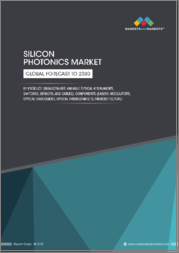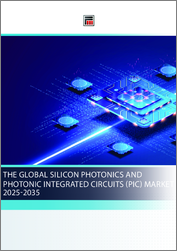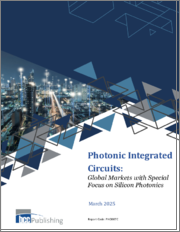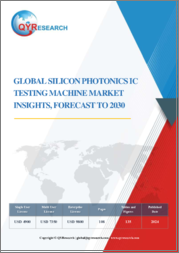
|
시장보고서
상품코드
1635866
실리콘 포토닉스 시장 보고서 : 제품별, 구성요소별, 용도별, 지역별(2025-2033년)Silicon Photonics Market Report by Product, Component (Optical Waveguides, Optical Modulators, Photodetectors, Wavelength-Division Multiplexing Filters, Laser), Application, and Region 2025-2033 |
||||||
실리콘 포토닉스 시장 세계 시장 규모는 2024년에 21억 달러에 달했습니다. 향후 IMARC Group은 2033년에는 148억 달러에 달해 2025년부터 2033년까지 24.1%의 연평균 성장률(CAGR)을 기록할 것으로 예상하고 있습니다. 소형 전자기기에 대한 수요 증가, 고속 데이터 부하에 대한 수요 증가, 운영 비용 절감을 위한 에너지 효율 지향성 증가 등이 시장 성장의 주요 요인으로 작용하고 있습니다.
실리콘 포토닉스는 실리콘의 고유한 특성을 이용하여 전기 신호가 아닌 빛으로 데이터를 조작하고 전송하는 기술입니다. 레이저, 변조기, 검출기 등 다양한 광 부품을 실리콘 기반 반도체 칩에 직접 집적합니다. 보다 빠르고 효율적인 통신 네트워크를 구현하는 데 중요한 역할을 하고 있습니다. 장거리 및 데이터센터 내 정보 전송에 빛의 힘을 이용하여 고속 데이터 전송 및 에너지 소비 감소를 지원하기 위해 실리콘 포토닉스에 대한 수요가 전 세계적으로 증가하고 있습니다.
현재 기존 반도체 제조 공정과 원활하게 통합할 수 있는 실리콘 포토닉스의 채택이 증가하고 있으며, 이는 시장 성장에 기여하고 있습니다. 이에 따라 고속 데이터 전송 문제를 해결하기 위한 비용 효율적이고 확장성이 뛰어난 솔루션에 대한 요구가 증가하고 있는 것도 시장 성장을 뒷받침하고 있습니다. 또한, 실리콘 포토닉스 부품의 비용을 절감하고 보다 광범위한 산업에서 사용할 수 있도록 제조 공정의 발전은 업계 투자자들에게 유리한 성장 기회를 제공하고 있습니다. 또한, 고성능 컴퓨팅에 대한 개인 수요의 증가는 시장에 긍정적인 영향을 미치고 있습니다. 또한, 의료 진단 및 이미징을 위한 바이오포토닉스에서 헬스케어 분야에서 실리콘 포토닉스의 채택이 증가하고 있는 것도 시장 성장을 촉진하고 있습니다. 이 외에도 자율주행차에서 광검출 및 거리측정(LiDAR)의 사용이 증가하면서 시장 성장을 강화하고 있습니다.
실리콘 포토닉스 시장 동향/촉진요인:
고속 데이터 부하 대응에 대한 요구 증가
데이터 트래픽의 증가로 인해 데이터 부하 문제를 빠르고 정확하게 해결해야 할 필요성이 높아지면서 시장 성장을 촉진하고 있습니다. 또한, 많은 산업의 디지털 전환, 온라인 컨텐츠 소비, 커넥티드 디바이스의 등장으로 실리콘 포토닉스의 채택이 증가하고 있습니다. 실리콘 포토닉스는 고속 데이터 전송 기능을 제공함으로써 이러한 문제를 해결하고 있습니다. 기존의 구리 기반 상호연결은 신뢰할 수 있는 솔루션을 제공할 수 없습니다. 이와는 별도로, 실리콘 포토닉스는 빛을 사용하여 데이터를 전송할 수 있어 더 높은 데이터 속도를 제공할 뿐만 아니라 장거리 신호 손실을 줄일 수 있어 효율적인 데이터 처리 및 저장이 필수적인 데이터센터에 적합합니다.
운영 비용 절감을 위한 에너지 효율 지향성 증가
운영 비용 절감을 위한 에너지 효율에 대한 관심이 높아지면서 시장 성장에 기여하고 있습니다. 이에 따라, 포토닉스는 기존의 전자식 상호연결에 대한 보다 에너지 효율적인 대안을 제공하는 데 도움이 되고 있습니다. 전자 데이터 전송은 열을 발생시키고 많은 양의 전력을 소비하기 때문에 냉각 비용이 큰 데이터센터에서는 특히 문제가 됩니다. 반면, 이 포토닉스는 빛의 조작에 의존하기 때문에 에너지 소비가 훨씬 적습니다. 이는 운영 비용을 절감할 뿐만 아니라 환경의 지속가능성에도 기여하기 때문에 시장 전망은 밝습니다. 또한, 다양한 조직이 이산화탄소 배출량을 최소화하고 운영 비용을 절감하는 데 주력하고 있습니다.
소형 전자기기에 대한 수요 증가
소형화의 확산으로 더 작고 컴팩트한 전자기기에 대한 수요가 증가하고 있는 것이 시장 성장에 기여하고 있습니다. 이와는 별도로, 이러한 포토닉스는 실리콘 웨이퍼 제조 공정을 활용하여 다양한 광학 부품을 단일 칩에 집적화하고 있습니다. 이러한 집적화는 광학 시스템의 물리적 풋프린트를 줄일 뿐만 아니라 설계 및 조립을 단순화합니다. 이에 따라 다기능 및 고집적 광 회로의 개발이 가능해져 소형화 애플리케이션에 대한 매력이 더욱 높아집니다. 또한, 다양한 산업에서 전 세계의 많은 소비자층을 끌어들이기 위해 더 작고 휴대 가능한 디바이스를 개발하고 있습니다.
목차
제1장 서문
제2장 조사 범위와 조사 방법
- 조사 목적
- 이해관계자
- 데이터 소스
- 1차 정보
- 2차 정보
- 시장 추정
- 상향식 접근
- 하향식 접근
- 조사 방법
제3장 주요 요약
제4장 소개
- 개요
- 주요 업계 동향
제5장 세계의 실리콘 포토닉스 시장
- 시장 개요
- 시장 실적
- COVID-19의 영향
- 시장 예측
제6장 시장 내역 : 제품별
- 트랜시버
- 시장 동향
- 시장 예측
- 액티브 광케이블(AOC)
- 시장 동향
- 시장 예측
- 광멀티플렉서
- 시장 동향
- 시장 예측
- 광감쇠기
- 시장 동향
- 시장 예측
- 기타
- 시장 동향
- 시장 예측
제7장 시장 내역 : 구성요소별
- 광도파로
- 시장 동향
- 시장 예측
- 광변조기
- 시장 동향
- 시장 예측
- 광검출기
- 시장 동향
- 시장 예측
- 파장 분할 다중(WDM) 필터
- 시장 동향
- 시장 예측
- 레이저
- 시장 동향
- 시장 예측
제8장 시장 내역 : 용도별
- IT 및 통신
- 시장 동향
- 시장 예측
- 가전제품
- 시장 동향
- 시장 예측
- 헬스케어와 생명과학
- 시장 동향
- 시장 예측
- 상업
- 시장 동향
- 시장 예측
- 방위와 안보
- 시장 동향
- 시장 예측
- 기타
- 시장 동향
- 시장 예측
제9장 시장 내역 : 지역별
- 북미
- 미국
- 캐나다
- 아시아태평양
- 중국
- 일본
- 인도
- 한국
- 호주
- 인도네시아
- 기타
- 유럽
- 독일
- 프랑스
- 영국
- 이탈리아
- 스페인
- 러시아
- 기타
- 라틴아메리카
- 브라질
- 멕시코
- 기타
- 중동 및 아프리카
제10장 촉진요인, 억제요인, 기회
- 개요
- 성장 촉진요인
- 성장 억제요인
- 기회
제11장 밸류체인 분석
제12장 Porter's Five Forces 분석
- 개요
- 구매자의 교섭력
- 공급 기업의 교섭력
- 경쟁 정도
- 신규 참여업체의 위협
- 대체품의 위협
제13장 가격 분석
제14장 경쟁 구도
- 시장 구조
- 주요 기업
- 주요 기업 개요
- AIO Core Co. Ltd.
- Broadcom Limited
- Cisco Systems Inc.
- Global Foundries
- Hamamatsu Photonics K.K
- Intel Corporation
- Sicoya Gmbh
The global silicon photonics market size reached USD 2.1 Billion in 2024. Looking forward, IMARC Group expects the market to reach USD 14.8 Billion by 2033, exhibiting a growth rate (CAGR) of 24.1% during 2025-2033. The growing demand for compact and smaller electronic devices, rising need to address data load with high speed, and increasing preference for energy efficiency to reduce operational costs are some of the major factors propelling the market.
Silicon photonics is a technology that leverages the unique properties of silicon to manipulate and transmit data using light rather than electrical signals. It integrates various optical components, such as lasers, modulators, and detectors, directly onto silicon-based semiconductor chips. It plays a crucial role in enabling faster and more efficient communication networks. As it assists in offering high-speed data transmission and lowering energy consumption by utilizing the power of light to transmit information over long distances and within data centers, the demand for silicon photonics is increasing across the globe.
At present, the rising adoption of silicon photonics, as it can seamlessly integrate with existing semiconductor fabrication processes, is contributing to the growth of the market. In line with this, the increasing need for cost-effective and scalable solutions for addressing high-speed data transmission problems is supporting the growth of the market. Additionally, advancements in manufacturing processes to reduce the cost of silicon photonics components and make them more accessible to a broader range of industries are providing lucrative growth opportunities to industry investors. In addition, the growing demand for high-performance computing among individuals is positively influencing the market. Furthermore, the increasing employment of silicon photonics in the healthcare sector in biophotonics for medical diagnostics and imaging is impelling the growth of the market. Besides this, the rising utilization of light detection and ranging (LiDAR) in autonomous vehicles is strengthening the growth of the market.
Silicon Photonics Market Trends/Drivers:
Rising need to address data load with high-speed
The rising need to solve data load problems with high speed and accuracy due to the increasing data traffic is bolstering the growth of the market. In addition, there is a rise in the adoption of silicon photonics due to the digital transformation of numerous industries, online content consumption, and the emergence of connected devices. This photonics addresses these challenges by offering high-speed data transmission capabilities. Traditional copper-based interconnects are not capable of providing reliable solutions. Apart from this, silicon photonics can transmit data using light, not only delivering higher data rates but also reducing signal loss over long distances, which makes them suitable for data centers, where the need for efficient data processing and storage is critical.
Increasing preference for energy efficiency to reduce operational costs
The increasing preference for energy efficiency to reduce operational costs is contributing to the growth of the market. In line with this, this photonics assist in offering a more energy-efficient alternative to traditional electronic interconnects. Electronic data transmission generates heat and consumes substantial power, which is particularly problematic in data centers where cooling costs are a significant expense. On the other hand, this photonics rely on the manipulation of light, which consumes considerably less energy. This not only reduces operational costs but also contributes to environmental sustainability, which is offering a positive market outlook. Furthermore, various organizations are focusing on minimizing their carbon footprint and reducing operational expenses.
Growing demand for compact and smaller electronic devices
The rising demand for smaller and more compact electronic devices due to the increasing popularity of miniaturization is contributing to the growth of the market. Apart from this, these photonics leverages silicon wafer fabrication processes to integrate various optical components onto a single chip. This integration not only reduces the physical footprint of optical systems but also simplifies their design and assembly. In line with this, it enables the development of multifunctional and highly integrated photonic circuits that further enhance its appeal in miniaturized applications. Furthermore, various industries are creating more compact and portable devices to attract a large consumer base across the globe.
Silicon Photonics Industry Segmentation:
Breakup by Product:
Transceivers
Active Optical Cables
Optical Multiplexers
Optical Attenuators
Others
Transceivers represents the largest market segment
Breakup by Component:
Optical Waveguides
Optical Modulators
Photodetectors
Wavelength-Division Multiplexing (WDM) Filters
Laser
Laser accounts for the majority of the market share
Breakup by Application:
IT and Telecommunications
Consumer Electronics
Healthcare and Life Sciences
Commercial
Defense and Security
Others
IT and telecommunications hold the biggest market share
Breakup by Region:
North America
United States
Canada
Asia Pacific
China
Japan
India
South Korea
Australia
Indonesia
Others
Europe
Germany
France
United Kingdom
Italy
Spain
Russia
Others
Latin America
Brazil
Mexico
Others
Middle East and Africa
Asia Pacific exhibits a clear dominance, accounting for the largest silicon photonics market share
The market research report has also provided a comprehensive analysis of all the major regional markets, which include North America (the United States and Canada); Asia Pacific (China, Japan, India, South Korea, Australia, Indonesia, and others); Europe (Germany, France, the United Kingdom, Italy, Spain, Russia, and others); Latin America (Brazil, Mexico, and others); and the Middle East and Africa. According to the report, Asia Pacific accounted for the largest market share.
Asia Pacific held the biggest market share due to the presence of large electronics manufacturing hubs. Apart from this, the rising demand for optical interconnect solutions due to the burgeoning telecommunications sector is contributing to the growth of the market in the region. In line with this, favorable government initiatives for enhanced telecommunications are supporting the growth of the market in the Asia Pacific region. Furthermore, the rising deployment of fifth generation (5G) networks is propelling the growth of the market.
Competitive Landscape:
Major manufacturers in the industry are continuously exploring new materials, fabrication techniques, and design innovations to enhance the performance and efficiency of these components. This includes improving data transmission speeds, reducing power consumption, and expanding the wavelength range. Additionally, they are focusing on developing a wide range of products, such as transceivers, lasers, modulators, detectors, and switches. These products are tailored to meet the specific needs of various applications, from high-speed data centers to fifth generation (5G) networks and light detection and ranging (lidar) systems for autonomous vehicles. Moreover, companies are working on integrating this photonics into existing electronic and photonic systems by developing hybrid integration solutions.
The report has provided a comprehensive analysis of the competitive landscape in the market. Detailed profiles of all major companies have also been provided. Some of the key players in the market include:
AIO Core Co. Ltd.
Broadcom Limited
Cisco Systems Inc.
Global Foundries
Hamamatsu Photonics K.K
Intel Corporation
Sicoya Gmbh
Key Questions Answered in This Report
- 1. How big is the global silicon photonics market?
- 2. What is the expected growth rate of the global silicon photonics market during 2025-2033?
- 3. What are the key factors driving the global silicon photonics market?
- 4. What has been the impact of COVID-19 on the global silicon photonics market?
- 5. What is the breakup of the global silicon photonics market based on the product?
- 6. What is the breakup of the global silicon photonics market based on the component?
- 7. What is the breakup of the global silicon photonics market based on the application?
- 8. What are the key regions in the global silicon photonics market?
- 9. Who are the key players/companies in the global silicon photonics market?
Table of Contents
1 Preface
2 Scope and Methodology
- 2.1 Objectives of the Study
- 2.2 Stakeholders
- 2.3 Data Sources
- 2.3.1 Primary Sources
- 2.3.2 Secondary Sources
- 2.4 Market Estimation
- 2.4.1 Bottom-Up Approach
- 2.4.2 Top-Down Approach
- 2.5 Forecasting Methodology
3 Executive Summary
4 Introduction
- 4.1 Overview
- 4.2 Key Industry Trends
5 Global Silicon Photonics Market
- 5.1 Market Overview
- 5.2 Market Performance
- 5.3 Impact of COVID-19
- 5.4 Market Forecast
6 Market Breakup by Product
- 6.1 Transceivers
- 6.1.1 Market Trends
- 6.1.2 Market Forecast
- 6.2 Active Optical Cables
- 6.2.1 Market Trends
- 6.2.2 Market Forecast
- 6.3 Optical Multiplexers
- 6.3.1 Market Trends
- 6.3.2 Market Forecast
- 6.4 Optical Attenuators
- 6.4.1 Market Trends
- 6.4.2 Market Forecast
- 6.5 Others
- 6.5.1 Market Trends
- 6.5.2 Market Forecast
7 Market Breakup by Component
- 7.1 Optical Waveguides
- 7.1.1 Market Trends
- 7.1.2 Market Forecast
- 7.2 Optical Modulators
- 7.2.1 Market Trends
- 7.2.2 Market Forecast
- 7.3 Photodetectors
- 7.3.1 Market Trends
- 7.3.2 Market Forecast
- 7.4 Wavelength-Division Multiplexing (WDM) Filters
- 7.4.1 Market Trends
- 7.4.2 Market Forecast
- 7.5 Laser
- 7.5.1 Market Trends
- 7.5.2 Market Forecast
8 Market Breakup by Application
- 8.1 IT and Telecommunications
- 8.1.1 Market Trends
- 8.1.2 Market Forecast
- 8.2 Consumer Electronics
- 8.2.1 Market Trends
- 8.2.2 Market Forecast
- 8.3 Healthcare and Life Sciences
- 8.3.1 Market Trends
- 8.3.2 Market Forecast
- 8.4 Commercial
- 8.4.1 Market Trends
- 8.4.2 Market Forecast
- 8.5 Defense and Security
- 8.5.1 Market Trends
- 8.5.2 Market Forecast
- 8.6 Others
- 8.6.1 Market Trends
- 8.6.2 Market Forecast
9 Market Breakup by Region
- 9.1 North America
- 9.1.1 United States
- 9.1.1.1 Market Trends
- 9.1.1.2 Market Forecast
- 9.1.2 Canada
- 9.1.2.1 Market Trends
- 9.1.2.2 Market Forecast
- 9.1.1 United States
- 9.2 Asia-Pacific
- 9.2.1 China
- 9.2.1.1 Market Trends
- 9.2.1.2 Market Forecast
- 9.2.2 Japan
- 9.2.2.1 Market Trends
- 9.2.2.2 Market Forecast
- 9.2.3 India
- 9.2.3.1 Market Trends
- 9.2.3.2 Market Forecast
- 9.2.4 South Korea
- 9.2.4.1 Market Trends
- 9.2.4.2 Market Forecast
- 9.2.5 Australia
- 9.2.5.1 Market Trends
- 9.2.5.2 Market Forecast
- 9.2.6 Indonesia
- 9.2.6.1 Market Trends
- 9.2.6.2 Market Forecast
- 9.2.7 Others
- 9.2.7.1 Market Trends
- 9.2.7.2 Market Forecast
- 9.2.1 China
- 9.3 Europe
- 9.3.1 Germany
- 9.3.1.1 Market Trends
- 9.3.1.2 Market Forecast
- 9.3.2 France
- 9.3.2.1 Market Trends
- 9.3.2.2 Market Forecast
- 9.3.3 United Kingdom
- 9.3.3.1 Market Trends
- 9.3.3.2 Market Forecast
- 9.3.4 Italy
- 9.3.4.1 Market Trends
- 9.3.4.2 Market Forecast
- 9.3.5 Spain
- 9.3.5.1 Market Trends
- 9.3.5.2 Market Forecast
- 9.3.6 Russia
- 9.3.6.1 Market Trends
- 9.3.6.2 Market Forecast
- 9.3.7 Others
- 9.3.7.1 Market Trends
- 9.3.7.2 Market Forecast
- 9.3.1 Germany
- 9.4 Latin America
- 9.4.1 Brazil
- 9.4.1.1 Market Trends
- 9.4.1.2 Market Forecast
- 9.4.2 Mexico
- 9.4.2.1 Market Trends
- 9.4.2.2 Market Forecast
- 9.4.3 Others
- 9.4.3.1 Market Trends
- 9.4.3.2 Market Forecast
- 9.4.1 Brazil
- 9.5 Middle East and Africa
- 9.5.1 Market Trends
- 9.5.2 Market Breakup by Country
- 9.5.3 Market Forecast
10 Drivers, Restraints, and Opportunities
- 10.1 Overview
- 10.2 Drivers
- 10.3 Restraints
- 10.4 Opportunities
11 Value Chain Analysis
12 Porters Five Forces Analysis
- 12.1 Overview
- 12.2 Bargaining Power of Buyers
- 12.3 Bargaining Power of Suppliers
- 12.4 Degree of Competition
- 12.5 Threat of New Entrants
- 12.6 Threat of Substitutes
13 Price Analysis
14 Competitive Landscape
- 14.1 Market Structure
- 14.2 Key Players
- 14.3 Profiles of Key Players
- 14.3.1 AIO Core Co. Ltd.
- 14.3.1.1 Company Overview
- 14.3.1.2 Product Portfolio
- 14.3.2 Broadcom Limited
- 14.3.2.1 Company Overview
- 14.3.2.2 Product Portfolio
- 14.3.2.3 Financials
- 14.3.2.4 SWOT Analysis
- 14.3.3 Cisco Systems Inc.
- 14.3.3.1 Company Overview
- 14.3.3.2 Product Portfolio
- 14.3.3.3 Financials
- 14.3.3.4 SWOT Analysis
- 14.3.4 Global Foundries
- 14.3.4.1 Company Overview
- 14.3.4.2 Product Portfolio
- 14.3.4.3 Financials
- 14.3.5 Hamamatsu Photonics K.K
- 14.3.5.1 Company Overview
- 14.3.5.2 Product Portfolio
- 14.3.5.3 Financials
- 14.3.5.4 SWOT Analysis
- 14.3.6 Intel Corporation
- 14.3.6.1 Company Overview
- 14.3.6.2 Product Portfolio
- 14.3.6.3 Financials
- 14.3.6.4 SWOT Analysis
- 14.3.7 Sicoya Gmbh
- 14.3.7.1 Company Overview
- 14.3.7.2 Product Portfolio
- 14.3.1 AIO Core Co. Ltd.
Kindly note that this only represents a partial list of companies, and the complete list has been provided in the report.



















